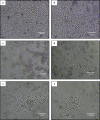Phytochemical characterization and evaluation of antioxidant, antimicrobial, antibiofilm and anticancer activities of ethyl acetate seed extract of Hydnocarpus laurifolia (Dennst) Sleummer
- PMID: 35959166
- PMCID: PMC9360287
- DOI: 10.1007/s13205-022-03267-3
Phytochemical characterization and evaluation of antioxidant, antimicrobial, antibiofilm and anticancer activities of ethyl acetate seed extract of Hydnocarpus laurifolia (Dennst) Sleummer
Abstract
Various functional groups were observed in the FTIR analysis of Hydnocarpus laurifolia seeds ethyl acetate extract such as O-H, N-H, C-H, -CH2, O=C=O, C=O, C=O-NH, and CH3, etc. Eleven bioactive compounds were detected via GC-MS and the predominant compounds include (1S)-2-cyclopentene-1-tridecanoicacid (chaulmoogric acid) (80.59%); 2-cyclopentene-1-undecanoic acid (hydnocarpic acid) (6.76%); cyclobutylamine (5.28%); methyl thioacetate (ethanethioic acid) (4.84%); lignoceric acid (2.21%). The TPC and TFC values were 0.110 ± 0.04 GAE g-1 and 0.175 ± 0.05 g CE g-1 respectively. Ethyl acetate extract showed strong DDPH free radical scavenging activity with IC50 value 10.64 ± 0.48 µg ml-1 and antioxidant activity index 3.759. The ethyl acetate extract also exhibited potential ABTS radical scavenging efficacy with a very low IC50 value, i.e., 07.81 ± 0.48 µg ml-1. P. aeruginosa was the most sensitive bacteria to the extract with 33.16 ± 0.88 mm inhibition zone and MIC: 3.12 mg ml-1, MBC: 6.25 mg ml-1. P. aeruginosa biofilm was inhibited by ethyl acetate extract 99.22% at MIC concentration. The LM images displayed a decrease in the number of biofilm cells and FE-SEM micrographs showcased the extensive decrease as well as disintegration in biofilm. Additionally, ethyl acetate extract was found selectively cytotoxic to the K562 cancer cells having an IC50 of 25.41 μg ml-1 and barely cytotoxic to normal PBMCs having an IC50 of 482.54 μg ml-1, and the selectivity index value was 18.99. Data validate scientifically the traditional use of H. laurifolia seeds in folk medicines and confirmed that it can be used in modern phytomedicines as an antioxidant, antimicrobial, antibiofilm, and anticancer agent and is toxicologically safe.
Keywords: Antibiofilm activity; Anticancer activity; Antimicrobial activity; Antioxidant activity; FTIR; GC–MS; Hydnocarpus laurifolia.
© King Abdulaziz City for Science and Technology 2022, Springer Nature or its licensor holds exclusive rights to this article under a publishing agreement with the author(s) or other rightsholder(s); author self-archiving of the accepted manuscript version of this article is solely governed by the terms of such publishing agreement and applicable law.
Conflict of interest statement
Conflict of interestThe authors have no conflict of interest to disclose.
Figures











Similar articles
-
Antimicrobial, antibiofilm, antioxidant, anticancer, and phytochemical composition of the seed extract of Pongamia pinnata.Arch Microbiol. 2021 Sep;203(7):4005-4024. doi: 10.1007/s00203-021-02365-9. Epub 2021 May 26. Arch Microbiol. 2021. PMID: 34037822
-
Unveiling the Launaea nudicaulis (L.) Hook medicinal bioactivities: phytochemical analysis, antibacterial, antibiofilm, and anticancer activities.Front Microbiol. 2024 Oct 3;15:1454623. doi: 10.3389/fmicb.2024.1454623. eCollection 2024. Front Microbiol. 2024. PMID: 39421554 Free PMC article.
-
Thais savignyi tissue extract: bioactivity, chemical composition, and molecular docking.Pharm Biol. 2022 Dec;60(1):1899-1914. doi: 10.1080/13880209.2022.2123940. Pharm Biol. 2022. PMID: 36200747 Free PMC article.
-
Phytochemical screening and evaluation of in vitro antioxidant and antimicrobial activities of the indigenous medicinal plant Albizia odoratissima.Pharm Biol. 2017 Dec;55(1):1155-1161. doi: 10.1080/13880209.2017.1291694. Pharm Biol. 2017. PMID: 28219296 Free PMC article.
-
Biofilm inhibition mechanism from extract of Hymenocallis littoralis leaves.J Ethnopharmacol. 2018 Aug 10;222:121-132. doi: 10.1016/j.jep.2018.04.031. Epub 2018 Apr 24. J Ethnopharmacol. 2018. PMID: 29698774
Cited by
-
Sustainable biodegradation of malachite green dye by novel non-pathogenic Pseudomonas aeruginosa ED24.World J Microbiol Biotechnol. 2025 Jan 22;41(2):44. doi: 10.1007/s11274-025-04251-8. World J Microbiol Biotechnol. 2025. PMID: 39841300
-
A feasible approach for azo-dye (methyl orange) degradation by textile effluent isolate Serratia marcescens ED1 strain for water sustainability: AST identification, degradation optimization and pathway hypothesis.Heliyon. 2024 Jun 4;10(11):e32339. doi: 10.1016/j.heliyon.2024.e32339. eCollection 2024 Jun 15. Heliyon. 2024. PMID: 38961949 Free PMC article.
References
-
- Ahmad I, Mehmood Z, Mohammad F. Screening of some Indian medicinal plants for their antimicrobial properties. J Ethnopharmacol. 1998;62(2):183–193. - PubMed
-
- Arulmozhi P, Vijayakumar S, Kumar T. Phytochemical analysis and antimicrobial activity of some medicinal plants against selected pathogenic microorganisms. Microb Pathog. 2018;123:219–226. - PubMed
-
- Bhat MY, Gul MZ, Lohamror LR, Qureshi IA, Ghazi IA. An in vitro study of the antioxidant and antiproliferative properties of Artemisia absinthium- a potent medicinal plant. Free Radic Antioxid. 2018;8:18–25. doi: 10.5530/fra.2018.1.4. - DOI
LinkOut - more resources
Full Text Sources
Miscellaneous

